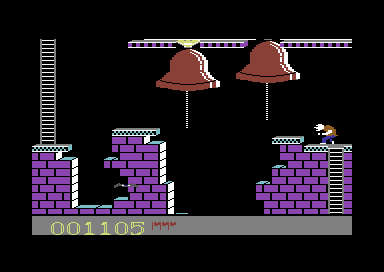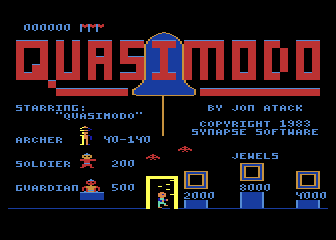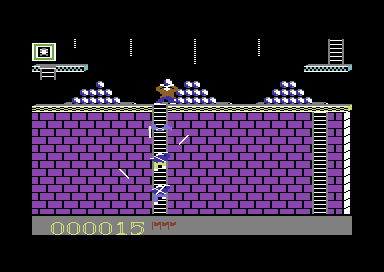Retro Replay Review
Gameplay
Quasimodo thrusts players into a relentless cycle of defense and ascent, starting with an iconic scene: a lone hunchback perched atop a medieval wall, rocks at the ready. The initial moments feel deceptively routine, as you hurl stones to knock invaders off ladders before they breach your perch. What begins as a simple reaction test soon evolves into a battle of multitasking, with arrows ricocheting off stone surfaces and enemies arriving in ever‐increasing numbers.
When the rock‐throwing phase concludes, Quasimodo’s focus shifts to upward mobility. The single action button becomes your lifeline for climbing ladders, making precision jumps over yawning pits, and swinging from suspended ropes attached to cavernous bells. Each gem you snag and deposit in the altar below unlocks a new area, but revives the same gauntlet of ladder‐climbers and airborne projectiles you’ve just survived, amplifying the challenge with each circuit.
As you progress, the difficulty ramps up in clever ways: battalions of bats join the fray, swooping unpredictably and delivering instant defeat if you misjudge their fluttering paths. Higher walls introduce parapet roll‐downs and archers firing at steeper angles. The interplay of vertical and horizontal threats—downward boulders versus upward‐firing arrows—keeps each run tense. Though the loop can border on Sisyphean repetition, mastering the timing of throws and swings offers a compelling test of hand‐eye coordination.
Graphics
Visually, Quasimodo channels the spirit of early platformers with richly detailed sprite work. The stonework of the walls, the ornate bells, and the medieval parapets all sport a muted palette of grays, browns, and slate blues, reinforcing the fortress atmosphere. The background architecture and sprawling towers scroll smoothly as you climb, conveying a sense of towering height.
Character animations are surprisingly fluid for the era. Quasimodo’s hunched posture and laborious throws feel weighty, while his leaps exhibit a satisfying curve. Enemies—whether armored knights or flapping bats—move with just enough frame count to feel alive without distracting from the action. Occasional flicker in crowded scenes is the only reminder of hardware limitations.
Despite a largely monochromatic environment, designers introduce subtle visual variety through lantern‐lit corridors, shadowy recesses, and occasional stained‐glass windows peeking in the distance. These set pieces break the monotony of stone and steel, even if the core architecture repeats across multiple screens. The game’s aesthetic leans into its grim, fortress‐bound setting, delivering a consistent tone from start to finish.
Story
Quasimodo’s narrative is minimal by modern standards, offering more a premise than a plot. You play the eponymous hunchback guarding an unnamed medieval stronghold against relentless sieges. There’s no cutscene exposition or voiced dialogue—just you, your rocks, and the echoing clang of armor on stone.
The hook lies in the legend of the bell‐ringer: a solitary defender whose only company is an ever‐present bat. While occasional hints suggest a greater world—perhaps a missing maiden or a hidden treasure—the game never reveals a clear motivation beyond the cyclical struggle. This ambiguity fuels a certain arcadian charm, leaving room for players’ imaginations to fill in the blanks.
Though there’s no romantic subplot or dramatic twist, the repetitive quests to retrieve and deposit glowing gems hint at an allegorical burden. Is Quasimodo clearing his conscience or merely toiling for an unseen master? The game’s refusal to answer adds a haunting edge, as you find yourself trapped in the same climb, fight, and retreat over and over, like an eternal bell‐ringer bound to the fortress walls.
Overall Experience
Quasimodo delivers an engaging blend of action and platforming, anchored by a distinctive medieval theme. Its straightforward controls and escalating challenge make it easy to pick up, yet difficult to master. Fans of precision timing and pattern recognition will appreciate each incremental increase in enemy numbers and attack angles.
However, the repetitive loop can become fatiguing. While each new circuit dials up the intensity—more bats, faster arrows, heavier boulders—the core tasks remain the same. Players seeking narrative depth or varied level design may find the experience one‐note after several runs.
That said, Quasimodo shines as a retro homage to arcade‐style endurance tests. Its moody graphics, minimalist story, and relentless pacing capture the grit of early single‐screen platformers. For gamers who relish tight controls, escalating difficulty, and the satisfaction of shaving seconds off their climb‐and‐throw runs, Quasimodo offers a solid, if unforgiving, medieval challenge.
 Retro Replay Retro Replay gaming reviews, news, emulation, geek stuff and more!
Retro Replay Retro Replay gaming reviews, news, emulation, geek stuff and more!









Reviews
There are no reviews yet.